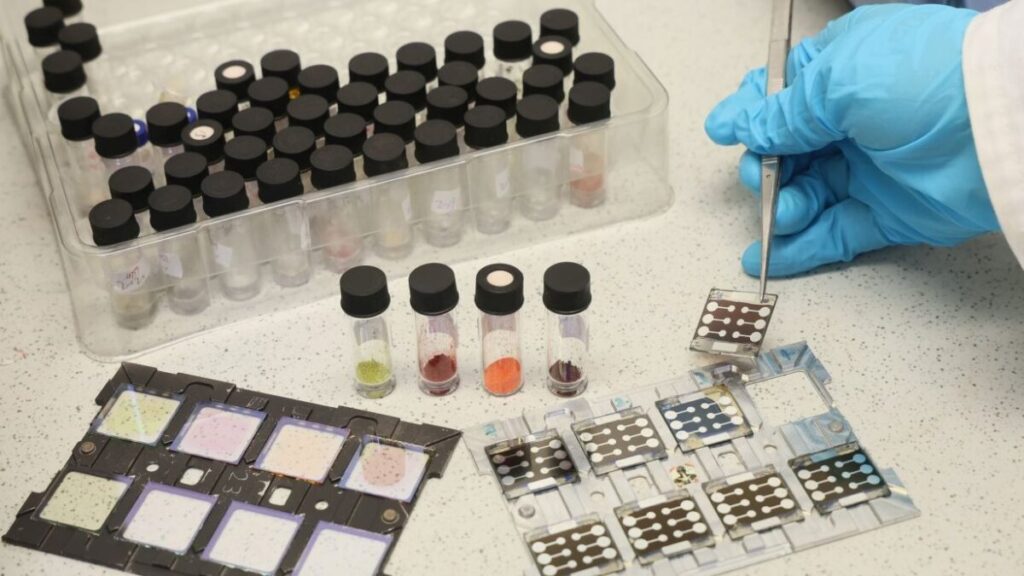An international team has combined organic synthesis with predictive modeling to discover new functional materials that improve the performance of hole transport layers used in perovskite solar cells. The team claims that optimization for other solar cell properties is possible with the platform, but also that it can be used to develop materials for other types of devices.
An international team led by the Helmholtz Institute Erlangen-Nürnberg for Renewable Energy (HI ERN), a branch of the German research institute Forschungszentrum Jülich, has combined organic synthesis with predictive models to discover new functional materials in a closed process. The so-called hybrid approach was applied to discover material for hole transport layers in perovskite solar cells. It involved the use of a large molecular descriptor database based on experiments, machine learning (ML) and validation through further high-throughput experiments.
The team discovered that in order to use machine learning and autonomous optimization algorithms, not only a sufficiently large data volume is needed, but also data diversity. To tackle that challenge, it started with a database of structural formulas of about a million virtual molecules that could be produced from commercially available substances.
Density functional theory (DFT) calculations and other computational tools were used and tailored to calculate a large number of possible hole transport materials (HTMs) for improving the performance of perovskite solar cells based on relevant structural features. “We then synthesized about 100 initial materials and tested them in solar cells, allowing us to train machine learning models to select two more batches of about 20 materials to maximize the efficiency of the solar cell devices,” says the corresponding author of the study, Pascal Friederich. , told pv magazine.
Molecules with different characteristics were automatically produced at HI ERN using a robotic system and used to fabricate otherwise identical solar cell, doping-free HTMs in pin-structured perovskite solar cell devices. The results for the series of HTMs showed an initial energy conversion efficiency of more than 20% after Bayesian optimization, according to the paper. These materials achieved an efficiency of no less than 26.2% and a certified efficiency of 25.9%.
Furthermore, the devices retained 80% of the initial performance for more than 1000 hours, which was attributed to the passivating properties of the new HTM, which more effectively suppressed non-radiative recombination at the interface. “For model selection, we trained several ML models on a random tenfold cross-validation of the 101 experimental molecular data points. ML models tested include random forest regression, linear regression, neural networks, GP regression, and kernel-ridge regression. All simple models performed equally well,” the team said.
“We were able to use the high throughput (HT) synthesis we developed for the wide range of molecules, and link experimental and theoretical data to discover new hole transport materials using Bayesian optimization. This is a promising research direction that uses machine learning to learn and understand, rather than just accelerate discovery,” said Anastasia Barabash, member of the research team. pv magazinehighlighting that the trained ML models can be used to learn more about the underlying relationship between microscopic molecular properties and macroscopic device performance.
Research first author Jianchang Wu said pv magazine that one of the challenges of the research was to consistently purify hundreds of molecules, maintain reproducibility from batch to batch, and to maintain uniform conditions among the “many environmental, crystallization, and process factors that can “substantially” influence the outcome . Such models could be further explored as autonomous workflows “to identify and predict even more new molecules” tailored for a variety of applications, the group noted, adding that it could also be used to improve perovskite performance predict devices of new molecular designs using extracted design rules. “elucidated from a fully trained model.”
Looking ahead, the group said it will integrate materials research and device optimization into a seamless, closed-loop process. “Achieving this will require a concerted effort in interdisciplinary research, combining insights from materials science, engineering and advanced computing techniques to create a synergistic workflow,” the report said.
The research work is described in the article “Inverse design workflow discovers hole transport materials tailored to perovskite solar cells”, recently published in Science.
The scientists who participated in the study came from the Helmholtz Institute Erlangen-Nürnberg for Renewable Energy (HI ERN), a branch of Forschungszentrum Jülich, Karlsruher Instituts für Technology (KIT), Friedrich Alexander University Erlangen Nürnberg (FAU), Ulsan National Institute of Science in South Korea, in China, the University of Groningen, in the Netherlands, as well as the University of Xiamen and the University of Electronics Science and Technology, both based in China.
This content is copyrighted and may not be reused. If you would like to collaborate with us and reuse some of our content, please contact: editors@pv-magazine.com.

